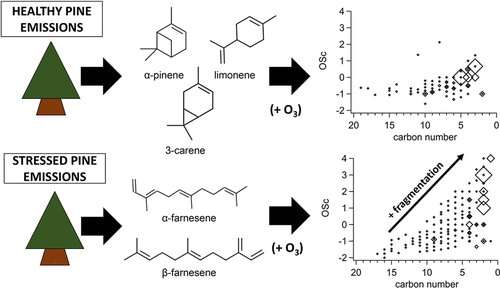Aphid-stressed pines show different secondary organic aerosol formation

Plants emit gases, called volatile organic compounds (VOCs), that enter the atmosphere, where they can interact with other natural and human-made molecules to form secondary organic aerosols (SOAs). These tiny, suspended particles influence atmospheric processes, such as cloud formation and sunlight scattering. Now, researchers reporting in ACS Earth and Space Chemistry have shown that aphid-infested Scots pine trees produce a different mixture of VOCs than healthy plants, which then leads to different SOAs.
Plant species emit a wide variety of VOCs, including terpenoids, benzenoids and plant stress compounds, and the mixture can change with environmental conditions, such as temperature, drought or insect outbreaks. Very few studies have examined SOA production from the full range of VOCs made by plants under different conditions, in particular, insect outbreaks that could become more prevalent in a changing climate. Therefore, Celia Faiola and colleagues wanted to compare VOC emissions and SOA production from Scots pines under healthy and aphid-stressed conditions.
The researchers brought potted Scots pines into the lab, half of which were infested with aphids, and collected and analyzed their VOC emissions. The biggest difference between the infested and healthy plants was in the production of a type of VOC called sesquiterpenes, which had different chemical structures and were produced at different levels. The team showed that these compounds would likely affect SOA formation, depending on various chemical processes, such as ozonolysis and photolysis, that occur in the atmosphere. Although the implications of these findings with regard to climate change are currently unclear, the experiments show that increased plant stress in a changing climate could influence SOA production, the researchers say.
More information: Celia L. Faiola et al. Secondary Organic Aerosol Formation from Healthy and Aphid-Stressed Scots Pine Emissions, ACS Earth and Space Chemistry (2019). DOI: 10.1021/acsearthspacechem.9b00118
Provided by American Chemical Society



















